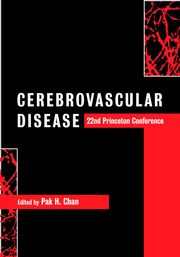Book contents
- Frontmatter
- Contents
- List of contributors
- Preface
- Acknowledgments
- Part I Special lectures
- Part II Oxidative stress
- Part III Apoptosis
- Part IV Hot topics
- Part V Hemorrhage, edema and secondary injury
- 14 The role of matrix metalloproteinases and urokinase in blood–brain barrier damage with thrombolysis
- 15 Does brain nitric oxide generation influence tissue oxygenation after severe human subarachnoid hemorrhage?
- 16 Tissue plasminogen activator and hemorrhagic brain injury
- 17 Dynamics of infarct evolution after permanent and transient focal brain ischemia in mice
- Part VI Inflammation
- Part VII Gene transfer and therapy
- Part VIII Neurogenesis and plasticity
- Part IX Magnetic resonance imaging in clinical stroke
- Part X Risk factors, clinical trials and new therapeutic horizons
- Index
- Plate section
17 - Dynamics of infarct evolution after permanent and transient focal brain ischemia in mice
from Part V - Hemorrhage, edema and secondary injury
Published online by Cambridge University Press: 02 November 2009
- Frontmatter
- Contents
- List of contributors
- Preface
- Acknowledgments
- Part I Special lectures
- Part II Oxidative stress
- Part III Apoptosis
- Part IV Hot topics
- Part V Hemorrhage, edema and secondary injury
- 14 The role of matrix metalloproteinases and urokinase in blood–brain barrier damage with thrombolysis
- 15 Does brain nitric oxide generation influence tissue oxygenation after severe human subarachnoid hemorrhage?
- 16 Tissue plasminogen activator and hemorrhagic brain injury
- 17 Dynamics of infarct evolution after permanent and transient focal brain ischemia in mice
- Part VI Inflammation
- Part VII Gene transfer and therapy
- Part VIII Neurogenesis and plasticity
- Part IX Magnetic resonance imaging in clinical stroke
- Part X Risk factors, clinical trials and new therapeutic horizons
- Index
- Plate section
Summary
Introduction
Acute occlusion of a large brain artery causes focal ischemia with a flow gradient that decreases from the peripheral to the more central parts of the occluded vascular territory. According to the threshold concept of brain ischemia, tissue viability is immediately endangered in the core of the ischemic territory in which blood flow declines below the critical level required to support energy metabolism. The surrounding penumbra is only functionally impaired, but with increasing time of vascular occlusion, tissue viability deteriorates until, within 6 to 12 hours, both the core and penumbra undergo ischemic infarction. If vascular occlusion is reversed, part of the ischemic territory may recover, depending on the duration and severity of the flow impairment. However, after a delay that can be as long as several weeks, a secondary type of brain injury may evolve, which leads to delayed infarction within the territory of the formerly occluded brain vessel. Finally, a spontaneous or drug-induced recirculation may occur, which differs from transient surgical occlusion by the slow restitution of flow, and which may aggravate rather than reverse ischemic injury.
Obviously, each of these ischemic conditions presents a different pathophysiology, with different requirements for therapeutic interventions. To analyze the underlying mechanisms it is necessary to describe, in a first step, the detailed regional and temporal evolution of tissue injury. A straightforward way to achieve this goal is the application of multiparametric imaging techniques to the various focal ischemia models.
- Type
- Chapter
- Information
- Cerebrovascular Disease22nd Princeton Conference, pp. 192 - 210Publisher: Cambridge University PressPrint publication year: 2002



